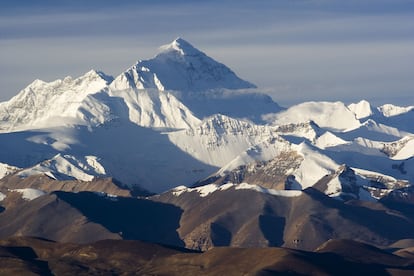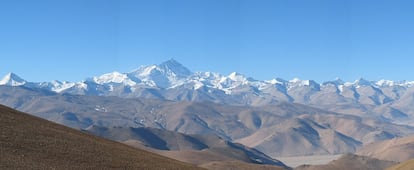Everest grows more than the rest of the ‘eight-thousanders’ thanks to a river that lightens its weight
River erosion in its environs explains why the world’s tallest mountain is up to 800 meters higher than the other towering peaks of the Himalayas

Mount Everest is growing by a few millimetres every year. This is hardly surprising, as the entire Himalayan mountain range is doing so. Dinosaurs still roamed the Earth when the collision of the Indian and Eurasian plates began to raise it. But the world’s highest mountain is between 238 meters (compared to K2) and 822 meters (compared to Shishapangma) taller than the other eight-thousanders. Now, Chinese and British geologists believe they have found the reason for this geological anomaly. According to the scientific journal Nature Geoscience, the Arun River, which runs around the mountain, is eroding its base, lightening its mass and raising it higher than its neighbouring peaks.
“The Arun River helps lift Mount Everest through a process called isostatic rebound,” says Jingen Dai, a geologist at the China University of Geosciences and the main author of the paper. If you think of the Earth’s crust as a flexible surface floating on denser material below, the mantle, “when the river erodes and drags huge amounts of rock from the valleys, it’s like taking weight off this floating surface; just as a ship rises higher in the water when its load is removed, the land responds by slowly rising upward,” Dai explains. This rebound effect has been observed in areas of the planet covered by large masses of ice, such as Greenland, which are melting at an accelerated rate. In a process called isostasy, the geosphere tends toward gravitational equilibrium. There, the causal agent would be the loss of water that goes to the sea; on Everest, this role would be played by the erosive force of the river. “In the case of the Arun, as it carves deeper valleys, the surrounding land, including Mount Everest, rises in response. This uplift is a way for the Earth to maintain balance, compensating for the mass removed by river erosion,” the Chinese geologist concludes.
For millennia and millennia, Everest rose at the same rate as the rest of the Himalaya range. At that time, the Arun flowed along the northern slope, on the Chinese and Tibetan sides, and from east to west. But about 69,000 years ago (a short period in geological terms), the river changed its course to the south, becoming trapped by the network of another larger river, the Kosi. Luis Carcavilla, a researcher from the Geological and Mining Institute of Spain (IGME), says that “the river made a 90-degree turn, going north-south, excavating one of the deepest gorges in the world.” In this process, called fluvial incision, and given its elevation and trajectory, the Arun causes great erosion at the base of Everest. “What they [the authors of the new research] are saying is that this very narrow canyon and this very anomalous route that goes west to east and suddenly north to south could have something to do with the rise of Everest,” he says. According to calculations by Chinese geologists, who insist that tectonics remains the main factor, rivers are responsible for up to a third of the difference in height with neighbouring mountains.

Francisco Moral, a geologist from Pablo de Olavide University, who did not participate in the research, points out what could have happened: “A small river, north-south, when it captures another river, west to east, greatly increases the size of the basin, its flow. If before we had a river that, let’s say, had a watershed of 10 km², when the capture occurs it can go up to 80 km². We are multiplying the watershed by eight. From that moment on, the flow increases and the erosive capacity increases.” According to the study’s calculations, the Arun has in this time receded some 700 meters downstream. “That erosion in the riverbed and downslope removes huge amounts of geologic material. As a consequence, we have less weight in that area of the crust, and around that gorge there is a typical uplift of the riverbed and the slope.”
The conclusion, supported by several models and the geological record, would be confirmed by the fact that the two other mountains closest to Everest, Lhotse and Makalu, are also rising at a faster rate. Isostatic rebound of the world’s fourth- and fifth-highest peaks would have increased in height by a similar amount to Everest. In fact, the second, located closer to the Arun River, would be experiencing a slightly higher rate of uplift.
Carcavilla, from the IGME, points out that in the last two decades, research has been carried out on “external geological processes, such as rain, glaciers […] that influence or can trigger certain internal processes.” Some of them are better studied, such as isostatic rebound due to melting ice. “But fluvial incision or glacial erosion is more recent,” he says. The geologist recalls that these processes and their impact are very difficult to quantify. But it is also important to try: “In fact, there are studies that maintain that the area of the Himalayas that rises the highest is the one where the monsoon is most intense, because it produces more erosion and that produces more rebound.” And the fate of a third of the world’s population depends largely on the monsoon.
How long will Everest continue to grow in height? Neither the authors of the study nor the geologists consulted can say for certain. There are many factors involved. Some are recounted by the Chinese researcher Dai: “The ongoing tectonic collision, which remains the main driver of uplift; the isostatic rebound caused by river erosion; and glacial erosion at high altitudes, which gradually wears away the summit. The interaction of these processes (tectonic uplift, isostatic rebound and erosion) will determine its final height.” But his colleague Carcavilla points out that Everest is already at its limit. In the past, there could only have been mountains this high on one occasion in the 4.5 billion years of Earth’s history. “The lithosphere has a limit to how much it can hold before it collapses,” he notes.
Sign up for our weekly newsletter to get more English-language news coverage from EL PAÍS USA Edition
Tu suscripción se está usando en otro dispositivo
¿Quieres añadir otro usuario a tu suscripción?
Si continúas leyendo en este dispositivo, no se podrá leer en el otro.
FlechaTu suscripción se está usando en otro dispositivo y solo puedes acceder a EL PAÍS desde un dispositivo a la vez.
Si quieres compartir tu cuenta, cambia tu suscripción a la modalidad Premium, así podrás añadir otro usuario. Cada uno accederá con su propia cuenta de email, lo que os permitirá personalizar vuestra experiencia en EL PAÍS.
¿Tienes una suscripción de empresa? Accede aquí para contratar más cuentas.
En el caso de no saber quién está usando tu cuenta, te recomendamos cambiar tu contraseña aquí.
Si decides continuar compartiendo tu cuenta, este mensaje se mostrará en tu dispositivo y en el de la otra persona que está usando tu cuenta de forma indefinida, afectando a tu experiencia de lectura. Puedes consultar aquí los términos y condiciones de la suscripción digital.
More information
Archived In
Últimas noticias
The metaverse, four years later: Is it finished or just at a standstill?
$3,000 and a plane ticket: The United States increases incentives for migrants to self-deport before the end of the year
Charles Dubouloz, mountaineering star, retires at 36 with a farewell tour inspired by Walter Bonatti
From the White House to diplomatic gifts: Lego wins over adult fans, brick by brick
Most viewed
- The low-cost creative revolution: How technology is making art accessible to everyone
- Christian Louboutin: ‘Young people don’t want to be like their parents. And if their parents wear sneakers, they’re going to look for something else’
- All the effects of gentrification in one corner of Mexico’s Colonia Roma
- Christmas loses its festive spirit: ICE fears cast shadow over religious celebrations
- Liset Menéndez de la Prida, neuroscientist: ‘It’s not normal to constantly seek pleasure; it’s important to be bored, to be calm’










































